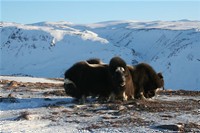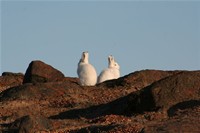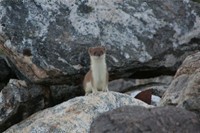Mammals of the region
The Mammals of Northeast Greenland
by Carsten Egevang, Greenland Institute of Natural Resources
Marine Mammals:
The king of the Arctic, the Polar Bear (Ursus marinus), is distributed over the entire region of North-East Greenland. The Polar Bear is associated with drift ice where it hunts its main prey, the Ringed Seal (Phoca hispida). Polar bears have high status among Inuit hunters and 50-70 animals are shot annually in the Tasilaq and Ittoqqortoormiit areas. Most parts of the animal are used; the skin is traded, the meat is a tasty and a rich source of energy in the cold season, and the skull and claws are sold for decorative purposes. This large animal wanders over enormous distances, following the drift ice south during Spring, and travelling north again in late Summer/Autumn. Although the Polar Bear can be found virtually anywhere in the vicinity of the sea, sightings are rare. It is potentially dangerous to humans, and firearms should always be carried when visiting areas outside Ittoqqortoormiit town.
The Atlantic Walrus (Odobenus rosmarus) is another characteristic mammal found in North-East Greenland. A large male may weigh as much as two tons. Their diet consists primarily of shallow-water invertebrates, such as mussels and clams, but the Walrus also occasionally hunts seals. During late summer the Walrus moults its fur in special “haul-out-sites” on land. The best known haul-out sites in North-East Greenland are located in the Dove Bugt area (c. 76°40′N), and on Sandøen in Young Sund near Daneborg (c. 74°15′N), where up to 50 animals may be present during August-September. The Walrus is quite sensitive to disturbances at the haul-out-site, and special caution should always be paid by keeping an appropriate distance, so the animals are not scared into the water. Walruses are also potentially dangerous to humans.
Several whale species occur in the waters of North-East Greenland but only the Narwhale (Monodon monoceros) occurs on a regular basis. This five metre long whale migrates into the many fjords in the area during summer. The most important areas for Narwhale in North-East Greenland are the inner branches of the Scoresby Sund fjord complex, where small flocks (usually 10-25 individuals) are common in the Summer. The Narwhale is an important species for the Inuit hunters of Ittoqqortoormiit. The skin and blubber (mattak) of the whale are considered a delicacy, and are a rich source of energy; the mattak from Ittoqqortoormiit is exported to West Greenland. The long (up to 2.5 metre) tusk of the male Narwhale is a valuable source of income for the local hunters.
Five species of seals occur commonly in North-East Greenland, but none is as important or as numerous as the Ringed Seal. This has a special adaptation to its ice-filled environment, with the ability to maintain its “breeding holes” in the sea ice throughout the winter. Ringed Seals use snow caves on the sea ice as breeding dens in March–May, and give birth to a single pup. Ringed Seals moult their fur in April–July, and individuals can commonly be seen resting on the drift ice and in the ice-filled fjords during this period. The Ringed Seal is an extremely important food source for both sledge dogs and humans of the region. Sealskins are also traded and exported from Ittoqqortoormiit to West Greenland. Both historically and today, the Ringed Seal has been the foundation for subsistence hunting in Ittoqqortoormiit, and several thousand individuals are harvested every year.
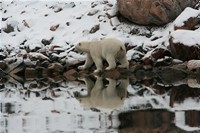
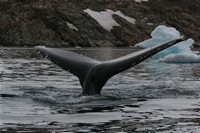
.JPG)
Land Mammals:
Although there are only six species of land mammals that inhabit North-East Greenland today, a little over a hundred years ago a reindeer (Rangifer tarandus) also roamed the tundra areas. It is thought that this reindeer became extinct due to climatic changes, and it is still possible to find relic reindeer antlers in the Scoresby Sund Fjord region.
Muskox (Ovibos moschatus) are found throughout North-East Greenland. Despite its name, the species is more closely related to the goat family than to cows. Muskox show a number of remarkable adaptations to the harsh and vegetation-poor environment. They have extremely thick fur and underwool for insulation, a broad muzzle for efficient and rapid foraging, and the ability to reduce their metabolic rate and food requirements during the Winter. One of the most important areas for Muskox in North-East Greenland is the large area of Jameson Land close to Ittoqqortoormiit. A few animals are shot every year, and limited trophy hunting is now possible.
The Arctic Hare (Lepus arcticus) and the Arctic Fox (Alopex lagopus) are commonly and widely distributed thoughout North-East Greenland, and there is a good chance that visitors to the area will be able to observe both species. The Stoat (Mustela erminea) and the Collared Lemming (Dicrostonyx torquatus) are also present throughout North-East Greenland, but are rarely seen due to their secretive behaviour. Although the Arctic Wolf (Canis lupus) has been recorded breeding in North-East and North Greenland, the Greenland wolf population probably depends on vagrants from northern Canada. It is estimated that only between 50 and 100 individuals inhabit the large landmass of Greenland.
